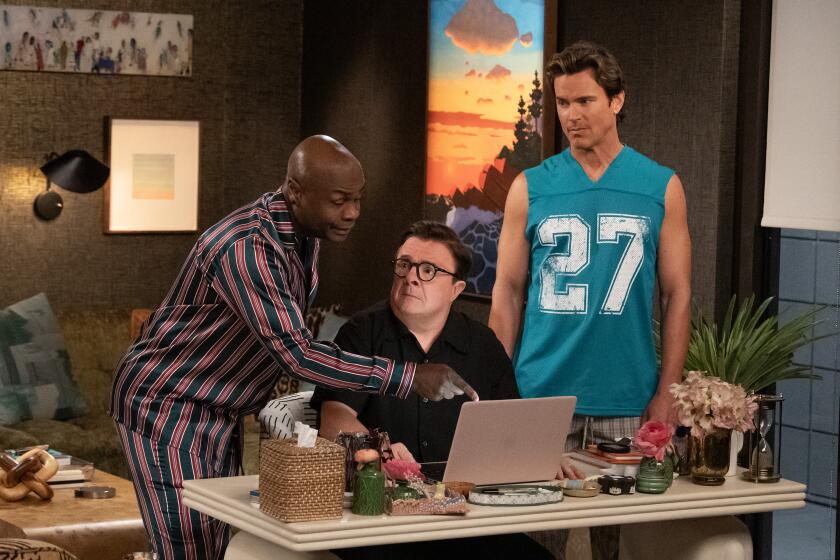Review: Moscow State Symphony goes big and bold in Northridge
- Share via
And still they come, one after another, an undeclared festival of touring orchestras that arrived in Southern California the last two weeks. Thursday night, it was Pavel Kogan and the Moscow State Symphony Orchestra’s turn in the Valley Performing Arts Center in Northridge.
Moscow played at VPAC (now also known as the Soraya) in November 2010, nearly three months before the hall officially opened, in a test of the acoustics. Their visit Thursday came the day after Valery Gergiev’s Mariinsky Orchestra appeared downtown at Walt Disney Concert Hall, giving L.A. orchestra fans the exceedingly rare opportunity to hear two Scriabin symphonies played by Russian orchestras on consecutive nights.
Kogan has been in charge of the Moscow orchestra since 1989, plenty of time to establish a sound and personality, and the personnel looked predominantly young and ready to burn. They stamped their presence in the hall immediately, producing a big, dark, growling sound in the cellos, basses and bassoons at the outset of Rachmaninoff’s early tone poem “The Rock” — another piece that doesn’t get played much around these parts.
The upper strings had exceptional transparency, all bowing as one unit with the same parts of the bows. Adopting fast tempos, Kogan worked his way up to the final climax that detonated with a thunderous roar, the brasses kicking in with that savage, buzzing timbre that I thought had disappeared along with the Soviet Union. As Stan Kenton once shouted, “This is an orchestra!”
The orchestra assumed a thicker, more opaque texture for 2015 Tchaikovsky Competition Gold Medal winner Dmitry Masleev’s clangorous manhandling of the Tchaikovsky Piano Concerto No. 1. A few nice streaks of color were overshadowed by blurs of chords and octaves pounded so loudly as to fear for the Steinway piano’s life. Masleev followed up with “Scene dansante; Invitation au trepak” from Tchaikovsky’s 18 Pieces Op. 72, slashing away as before.
Scriabin wrote five symphonies, only one of which, the Fourth — better-known as “The Poem of Ecstasy” — gets played with any regularity in America. The first three symphonies, sprawling hyper-Romantic essays all, clearly chart a progression toward the wild chromatic mysticism of Scriabin’s later symphonies. The Second Symphony, which Kogan and the Moscow orchestra played Thursday, might be the best of the three.
Kogan certainly made an excitingly cogent case for it, pressing the tempos forward urgently, letting it get wild and woolly in the right convulsive spots, with all heroic flags waving in the final Maestoso section. They pushed the limits of heart-on-sleeve expression in the slow movement, but never let it get out of hand.
The encores were generous in number: first, a lusciously-handled Rachmaninoff Vocalise, then the Waltz from Khachaturian’s “Masquerade” played fast and raucously with massive jolts of brash, brassy exuberance. Finally came Shostakovich’s cheeky arrangement of Vincent Youmans’ “Tea for Two” (also known as “Tahiti Trot”!) that the young composer dashed off on a dare. The orchestra heightened all of the funny details, especially the trombone slide.
SIGN UP for the free Essential Arts & Culture newsletter »
See all of our latest arts news and reviews at latimes.com/arts.
MORE MUSIC:
Susanna Malkki and the L.A. Phil’s ‘Midsummer Night’s Dream’
Russia’s secret weapon? Valery Gergiev and the Mariinsky’s rapturous music
With a farewell on the horizon, Zubin Mehta’s concert with the Israel Philharmonic is a triumph
A Venezuelan life force for the Master Chorale’s Day of the Dead program
More to Read
The biggest entertainment stories
Get our big stories about Hollywood, film, television, music, arts, culture and more right in your inbox as soon as they publish.
You may occasionally receive promotional content from the Los Angeles Times.










